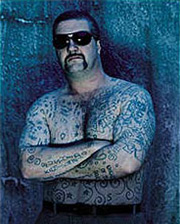 Main screening
Main screeningChopper (Andrew Dominik, 2000) 95 min.

This week's readings | Australasian biopics
Clips
The Story of the Kelly Gang (Charles Tait, 1906)
Hunt Angels (Alec Morgan, 2006)
Ned Kelly (Gregor Jordan, 2003)
The World's Fastest Indian (Roger Donaldson, 2006)
Phar Lap (Simon Wincer, 1983)
Molokai: The Story of Father Damien (Paul Cox, 2000)
Breaker Morant (Bruce Beresford, 1980)
 Main screening
Main screening
Chopper (Andrew Dominik, 2000) 95 min.
Custen defines the 'biographical film' as 'one which depicts the life of a historical person, past or present' (1992: 5), going on to argue that most biopics are 'minimally composed of the life, or the portion of a life, of a real person whose real name is used' (ibid.: 7). (Neale 2000: 61)
Custen is followed by both Neale and Moran, as his is the only book-length study of the biopic: Bio/Pics: How Hollywood Constructed Public History. Moran puts an Australian spin on the topic, looking at 'Aussie lives', and two overlapping thematic groups: the individual in the struggle against authority, and a sub-set of that: sons and fathers.
 Historically, the biopic is very significant in the Australian context. The world's first feature film, The Story of the Kelly Gang (Charles Tait, 1906), is also the first ever biopic. As this has now been released on DVD by the National Film and Sound Archive, I can show you a couple of minutes from this famous film.
Historically, the biopic is very significant in the Australian context. The world's first feature film, The Story of the Kelly Gang (Charles Tait, 1906), is also the first ever biopic. As this has now been released on DVD by the National Film and Sound Archive, I can show you a couple of minutes from this famous film.
Ken G. Hall's last film was a biopic: Smithy (1944). Charles Chauvel's last film, Jedda (1955), gave rise to a biopic of its leading actor (Robert) Tudawali (Steve Jodrell, 1987). The film that won best doco at the AFIs in 2006 was a biopic: Hunt Angels (Alec Morgan, 2006), the story of film-makers Rupert Kathner and Alma Brooks.
In order to organise this presentation, I found that I had first to organise the films identified as biopics into categories, and I found I could manage quite well with seven - as you see in the list of Australasian biopics - tho one is the rather pathetic 'other'. I would have thought of 'war' as a separate category, until I allowed myself to be influenced by Albert Moran's chapter - and so I've put it with 'adventure' for the present purpose. From the adventure/war combined category, I wish I could show you Ken G. Hall's Smithy (1944), based on the life of pioneer aviator Charles Kingsford-Smith - but not a single one of Hall's films is available on video, whether on tape or disk. I hope before I die to be able to buy a complete set of the films of Ken G. Hall and put them on the shelf next to my complete set of the films of Charles Chauvel - which are also unavailable on video in any format - except for Jedda (1955)! But I digress...
A category of biopic with a large membership in the Australian context is the bushranger film where the bushranger is named, as is often the case. At the time of writing I haven't drawn up my own list of bushranger films, nor included them in the adventure list, where they belong, as I want to be able to continue to draw your attention to Bill Routt's article in Senses of Cinema, which deals with them in the period 1904-1914. Some bushranger films obviously belong in the biopic group. At least one even has the word 'life' in its title: The Life And Adventures Of John Vane, The Notorious Australian Bushranger (S. A. [Stephen Australia] Fitzgerald, 1910), the Australian film with the longest title, by the way. Apart from the ubiquitous Ned Kelly, perhaps the most noticeable bushranger bioflick is Mad Dog Morgan (Philippe Mora, 1976), because of the participation of Dennis Hopper with David Gulpilil. Some people might think of Peter Finch as Captain Starlight in Robbery Under Arms (Jack Lee, 1957) - but he, however, was based on more than one real person.
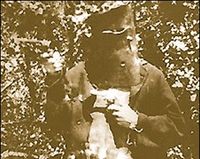 As Ned Kelly is the most frequently depicted historical person in Australian biopics, it's logical to start with him. Here's a very damaged section from a surviving print of the 1906 film.
As Ned Kelly is the most frequently depicted historical person in Australian biopics, it's logical to start with him. Here's a very damaged section from a surviving print of the 1906 film.
Clip from The Story of the Kelly Gang (Charles Tait, 1906): Kelly's last stand
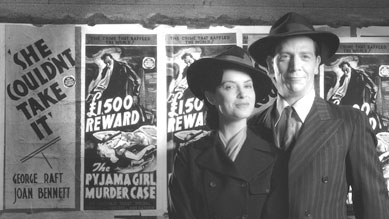 Hunt Angels (Alec Morgan, 2006) is the story of Rupert Kathner (1904-1954) and his partner Alma Brooks. I haven't yet been able to see any of the five feature films directed by Kathner, but I know that one of them is yet another Ned Kelly film, The Glenrowan Affair (1951). He was working in a period when we think of there being almost no Australian film industry at all, due to the domination of Hollywood, so it's remarkable that he was able to make these five shortish feature films. Hunt Angels won three awards at the AFIs in 2006 in documentary categories - including Best Documentary. I suppose this was to ensure that the film would get noticed among the other feature films, as it's very much a 'dramatised documentary'. It is an important film for a unit like this, not only giving an insight into the circumstances of film-making before and after the Second World War (as Newsfront [Phillip Noyce, 1979] did for an earlier period), but also displaying innovative digital compositing technique to create an effective illusion (as Newsfront also did in a more traditional way). Like Phar Lap, Alec Morgan is from Aotearoa.
Hunt Angels (Alec Morgan, 2006) is the story of Rupert Kathner (1904-1954) and his partner Alma Brooks. I haven't yet been able to see any of the five feature films directed by Kathner, but I know that one of them is yet another Ned Kelly film, The Glenrowan Affair (1951). He was working in a period when we think of there being almost no Australian film industry at all, due to the domination of Hollywood, so it's remarkable that he was able to make these five shortish feature films. Hunt Angels won three awards at the AFIs in 2006 in documentary categories - including Best Documentary. I suppose this was to ensure that the film would get noticed among the other feature films, as it's very much a 'dramatised documentary'. It is an important film for a unit like this, not only giving an insight into the circumstances of film-making before and after the Second World War (as Newsfront [Phillip Noyce, 1979] did for an earlier period), but also displaying innovative digital compositing technique to create an effective illusion (as Newsfront also did in a more traditional way). Like Phar Lap, Alec Morgan is from Aotearoa.
Clip from Hunt Angels (Alec Morgan, 2006): section dealing with The Glenrowan Affair (1951)
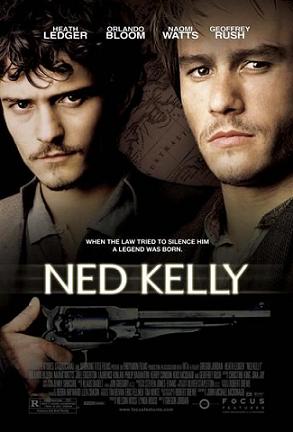 Ned Kelly (Gregor Jordan, 2003) was one of the big disappointments of 2003. I expected it to win AFI Best Film, but it wasn't even nominated for that award. Jordan's previous film with Heath Ledger Two Hands (1999) had taken off the two key awards, Best Direction and Best Film, so we were looking for something outstanding, especially with such an important topic, and adding Orlando Bloom and Geoffrey Rush to the mix. And in between Jordan had done well with Joaquin Phoenix in Buffalo Soldiers (2001). But Ned Kelly was too dark and too earnest and too long, and we were underwhelmed. Anyway, judge for yourself. Here's the height of the action: Ned's last stand. Check out the extra who got the gig because of his long beard.
Ned Kelly (Gregor Jordan, 2003) was one of the big disappointments of 2003. I expected it to win AFI Best Film, but it wasn't even nominated for that award. Jordan's previous film with Heath Ledger Two Hands (1999) had taken off the two key awards, Best Direction and Best Film, so we were looking for something outstanding, especially with such an important topic, and adding Orlando Bloom and Geoffrey Rush to the mix. And in between Jordan had done well with Joaquin Phoenix in Buffalo Soldiers (2001). But Ned Kelly was too dark and too earnest and too long, and we were underwhelmed. Anyway, judge for yourself. Here's the height of the action: Ned's last stand. Check out the extra who got the gig because of his long beard.
Clip from Ned Kelly (Gregor Jordan, 2003) [clip "last stand" 1.34.27 - 1.38.28]
Here's a bit from The World's Fastest Indian (Roger Donaldson, 2006) with Anthony Hopkins as Burt Munro (1899-1978), the motorcyclist from Invercargill, New Zealand who set a world speed record in 1967 at Bonneville Salt Flats in Utah, a record (183.58 mph, the under-1000cc world land speed record) which remains unbroken today.
He achieved this on an Indian Scout motorcycle (the picture shows a replica with the fairing cut away to show the bike) originally made in 1920 - tho Munro modified it over many years to the point of replacing almost everything!
Clip from The World's Fastest Indian (Roger Donaldson, 2006) [clip "Bonneville" 1.15.36 - 1.18.45]
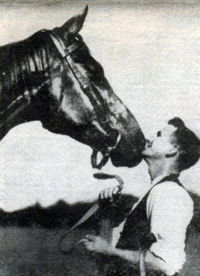
That was adventure. We come now to the closely related category of sport. I was about to write that only Australia could produce a film with a historical horse as folk hero, when I remembered Seabiscuit. There is something remarkable about the Australian obsession with horse-racing, however. Racing and betting are deep in the Australian character: almost the first film exposed in Australia (31 October 1896) had a horse race (the AJC Derby) as subject, and the oldest piece of sporting film preserved is of the 1896 Melbourne Cup, filmed on the first Tuesday in November that year. [note 1]
The photo shows strapper Tommy Woodcock with Phar Lap in 1930. The horse was born in New Zealand - like Russell Crowe and Jane Campion, other famous 'Australians'. It now seems that he was killed in the USA, not by some American conspiracy, but by his trainer, who gave him too much of the 'special tonic' - which included arsenic - that helped him run faster on the big day.
I'm not sure, but I think the clip I'll show - from the end of the film - mixes actuality with modern footage shot in b/w.
Clip from Phar Lap (Simon Wincer, 1983) [clip "hero" 1.48.20 - 1.49.55]
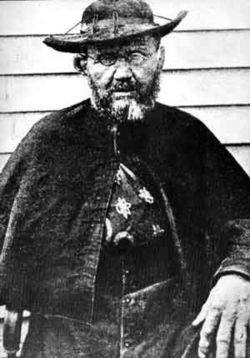
Molokai: The Story of Father Damien (Paul Cox, 2000), it seems to me, is a story of suicide by altruism. I'm all for service, for helping old ladies across the road and giving to the Salvos, but deliberately going to a leper colony when you know you're going to contract the disease and die seems a bit over the top to me. Somehow, Paul Cox, the leading Australian auteur, got together an extraordinary cast, and got most of them to go to the isolated Hawaiian island called Molokai to make this crock. Father Damien, unlike David Wenham, is on his way to sainthood.
To make it worth our while, I'll show you Peter O'Toole's big scene - with David Wenham, who of course gets acted off the screen. However, it's also a scene in which the Blessed Damien of Molokai - as he has been known since 1995, gives some information about why he is there.
Clip from Molokai: The Story of Father Damien (Paul Cox, 2000) [clip "breathe" 32.07 - 35.30]
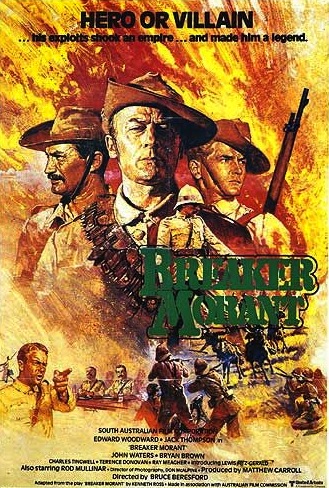 Breaker Morant (Bruce Beresford, 1980)
Breaker Morant (Bruce Beresford, 1980)
'The Breaker' was the nickname of Harry Morant, a horseman, poet and soldier. During his service in the Second Boer War, he ordered the execution of several Afrikaner and African prisoners, which led to his controversial court-martial and execution for murder by the British Army. Beresford's film suggests that he was a scape-goat.
The film stars British actor Edward Woodward as Harry 'Breaker' Morant. The supporting cast features Bryan Brown as Lieutenant Handcock, Lewis FitzGerald as Witton, and Jack Thompson as Major Thomas. A1978 play by Kenneth G. Ross was the source material for the screenplay, which Beresford co-wrote with Jonathan Hardy, David Stevens and Kenneth G. Ross. Although the action is set in South Africa, principal photography took place entirely in Australia.
I'll show part of the courtroom scene where Morant defends his position by invoking 'Rule 303' (referring to the bore of the standard issue Lee-Enfield rifle: 0.303 inches). Clip "303" 35.27 - 36.48
And then I'll show the ending with a poem by 'The Breaker' and his famous last line: 'Shoot straight you bastards! Don't make a mess of it!' Clip "ending" 1.32.34 - 1.37.50
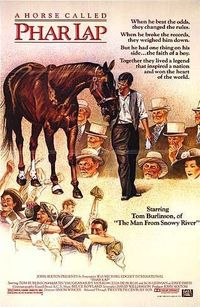
1. The first filming in Australia was undertaken by Marius Sestier, according to Shirley & Adams, in late September 1896. One example was Passengers Alighting from Ferry 'Brighton' at Manly, which I believe still exists. Graham Shirley & Brian Adams 1989, Australian Cinema: The First Eighty Years, revised edition, Currency Press, Sydney: 7-8.
Custen, George F. 1992, Bio/Pics: How Hollywood Constructed Public History, Rutgers University Press, New Brunswick.
Moran, Albert & Errol Vieth 2006, Film in Australia: An Introduction, CUP, Chapter 4: 'The Biopic'.
Neale, Steve 2000, 'Biopics', part of Chapter 3 of Genre and Hollywood, Routledge, London: 61-65.
Shirley, Graham & Brian Adams 1989, Australian Cinema: The First Eighty Years, revised edition, Currency Press, Sydney.
http://www.ironoutlaw.com/html/movies.html
New: 15 October, 2006 | Now: 27 April, 2022